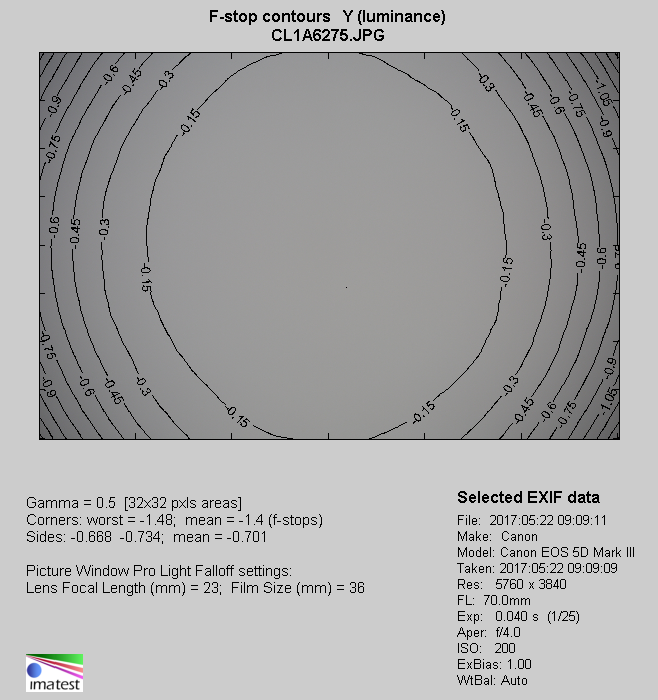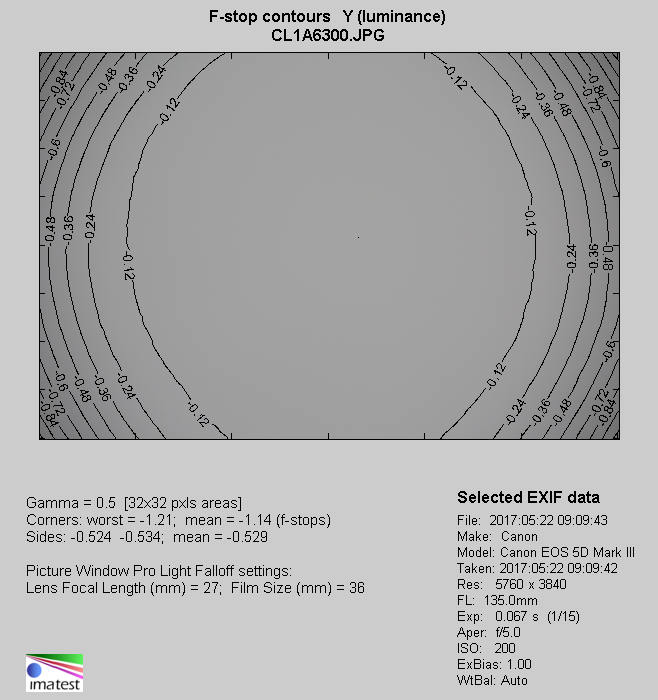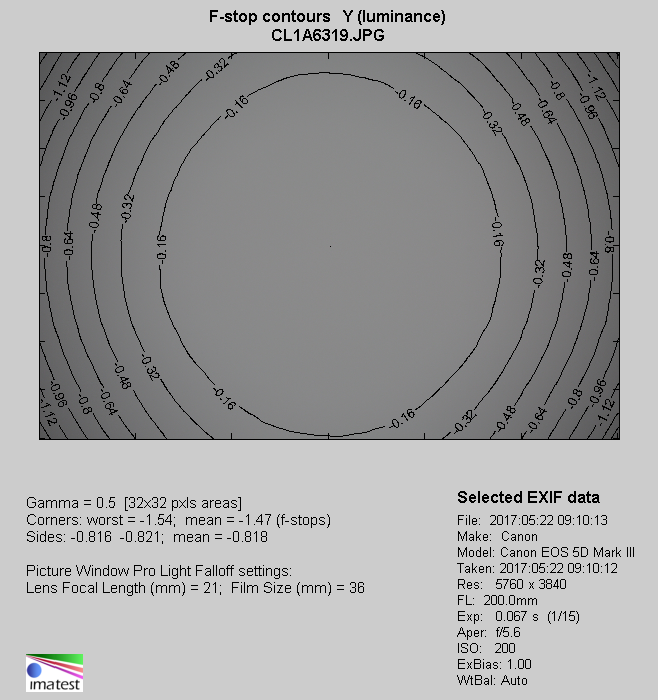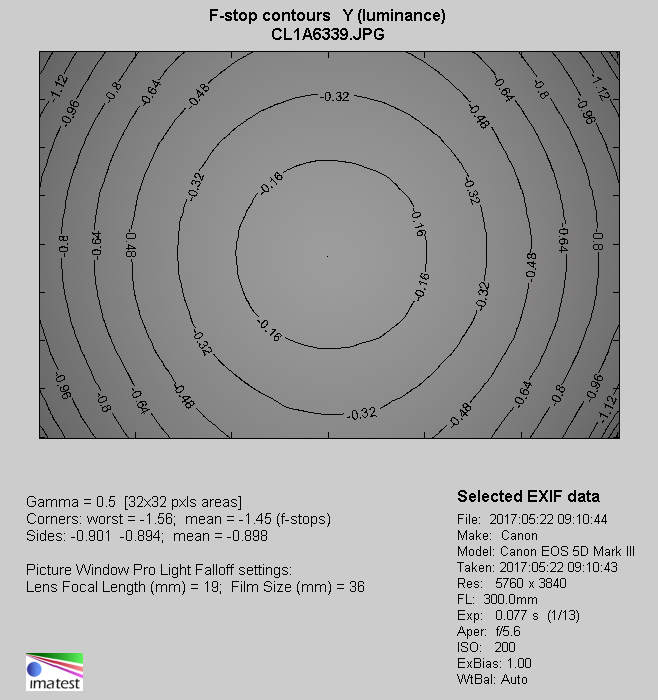Canon EF 70-300 mm f/4-5.6 IS II USM
8. Vignetting
| Canon 50D, 70 mm, f/4.0 | Canon 50D, 70 mm, f/5.6 |

|

|
| Canon 50D, 135 mm, f/5.0 | Canon 50D, 135 mm, f/5.6 |

|

|
| Canon 50D, 200 mm, f/5.6 | Canon 50D, 200 mm, f/8.0 |

|

|
| Canon 50D, 300 mm, f/5.6 | Canon 50D, 300 mm, f/8.0 |

|

|
There’s nothing alarming in these pictures, slight vignetting being visible at first glance only at the longest focal length, but it’s always worth checking objective measurements as well.
Please Support UsIf you enjoy our reviews and articles, and you want us to continue our work please, support our website by donating through PayPal. The funds are going to be used for paying our editorial team, renting servers, and equipping our testing studio; only that way we will be able to continue providing you interesting content for free. |
- - - - - - - - - - - - - - - - - - - - - - - - - - - - - - - - - - - - - - - - - - - - - - - -
At the 70 mm focal length, already at the maximum relative aperture the vignetting is hardly noticeable as its value amounts to just 11% (−0.34 EV). By f/5.6 it decreases to a negligible level of 6% (−0.17 EV).
The situation is even better at 135 mm where practically you can’t notice any vignetting at all even with the lens wide open – officially it reaches just 8% (−0.25 EV). At 200 mm on the other hand the situation is similar to the performance at the shortest focal length – the aberration is 13% (−0.44 EV) at the maximum relative aperture and it decreases to 6% (−0.18 EV) on stopping down by 1 EV.
As we mentioned above, the biggest chances to notice vignetting are at 300 mm where, by f/5.6, the brightness loss in the frame corners amounts to 21% (−0.70 EV); it decreases to 8% on stopping down the aperture to f/8.0.
Truncated circles of light, presented in the previous chapter, suggested that there might be more problems on the edge of full frame. Let’s check it now, assessing photos and measuring the results we got on the sensor of the Canon EOS 5D Mark III.
| Canon 5D III, 70 mm, f/4.0 | Canon 5D III, 70 mm, f/5.6 |

|

|
| Canon 5D III, 135 mm, f/5.0 | Canon 5D III, 135 mm, f/5.6 |

|

|
| Canon 5D III, 200 mm, f/5.6 | Canon 5D III, 200 mm, f/8.0 |

|

|
| Canon 5D III, 300 mm, f/5.6 | Canon 5D III, 300 mm, f/8.0 |

|

|
Employing a combination of 70 mm focal length and f/4.0 aperture you have to take into account a loss of 38% (−1.40 EV) of light in the frame corners. By using f/5.6 and f/8.0 apertures you are able to diminish that problem to, respectively, 20% (−0.64 EV) and 12% (−0.36 EV). The vignetting becomes completely imperceptible only by f/11 where it reaches 7% (−0.21 EV).
A bit better situation might be observed at 135 mm where, by f/5.0, we got 32% (−1.14 EV). On stopping down the lens to f/5.6 the vignetting decreases to 25% (−0.84 EV) and if you employ f/8.0 it gets even lower, to 12% (−0.38 EV). The problems disappear completely only by f/11 where the brightness loss is 6% (−0.19 EV).
The vignetting issues intensify again at the longer end of the focal lengths spectrum. At 200 mm and by f/5.6 light fall-off amounts to 40% (−1.47 EV) and it decreases to 18% (−0.59 EV) and to 10% (−0.31 EV) after employing respectively f/8 and f/11 apertures. Very similar results can be observed at the 300 mm focal length. At the maximum relative aperture brightness loss reaches 40% (−1.45 EV), then it decreases to 20% (−0.64 EV) after employing f/8.0 and to 10% (−0.30 EV) on stopping down to f/11.
These values are very close to the results of the bigger and more expensive L-series instrument as in its case the highest vignetting level also reached 40%. Still the Canon EF 70–300 mm f/4–5.6 IS II USM fares worse than lenses produced by independent companies: it is slightly weaker than the Tamron SP 70–300 mm VC USD and noticeably weaker than the Sigma 70–300 mm DG OS.
| Canon 5D Mk III, 70 mm, f/4.0 |
 |
| Canon 5D Mk III, 135 mm, f/5.0 |
 |
| Canon 5D Mk III, 200 mm, f/5.6 |
 |
| Canon 5D Mk III, 300 mm, f/5.6 |
 |






